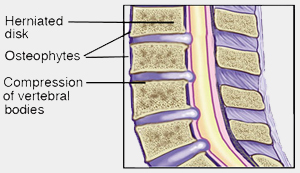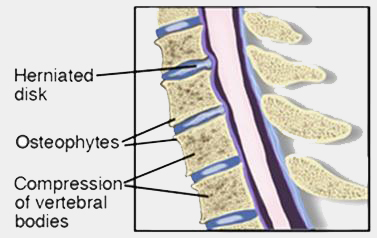By Michael E. Pomykala PT, DPT, OCS, CSCS
What is DDD?
Your spine is made up of 33 vertebrae that are stacked on top of one another. Between each of these vertebrae is a rubbery piece of cartilage called an “intervertebral disk.” When we’re younger, the disk is made mostly of gelatin. As we age, and sometimes with injury, we start to lose some of that gelatin. The disk becomes flatter and less flexible and the volume of the disk decreases, resulting in less space between the vertebrae. Sometimes bone spurs form in response to this degeneration of the disk, which could make the spine stiff.
Often, this flattening and additional stiffness to the spine is not at all painful. However, in some cases, pain and inflammation happen when the rough surfaces of the vertebral joints rub together.
Who is at risk?
We are all at risk for DDD, especially as we age. DDD is the natural result of the stress and strain we put on our backs every day. That said, you are more likely to develop DDD if you:
- Smoke
- Are obese
- Do heavy physical work
- Don’t get very much exercise
What are the signs?
DDD often manifests in mild to intense neck and back pain. The pain is often made worse by sitting, bending, and reaching. It may be worse first thing in the morning and after staying in any one position for a long time.
In severe cases, when DDD results in pressure on the nerve root, it can lead to numbness, tingling, and even weakness in the arms or legs.
How can Physical Therapy help?
Your Scerbo physical therapist will design a treatment program based on the evaluation of your DDD, and your personal goals. Your individualized treatment program may include specific exercises, such as:
- Stretching and flexibility exercises improve movement in the joints and muscles of your spine, arms, and legs. Improving motion in a joint is often the key to pain relief.
- Strengthening exercises for surrounding muscles, to help provide support for your spinal joints.
- Aerobic exercise such as walking, swimming, or taking a low-impact aerobics class, when done regularly can help relieve pain, promote a healthy body weight, and improve overall strength and mobility.
Your physical therapy program may also include manual (hands-on) therapy such as massage, as well as teaching you how to modify your posture and body mechanics to help relieve pain and manage your condition on a daily basis.
Your Scerbo Physical Therapist will work with you to help manage your DDD so you can continue in your desired daily activities and life roles.


